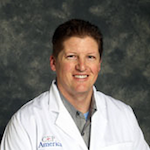Most hospital and health system leaders would prefer to staff their EDs with physicians who are residency trained and board-certified in emergency medicine (EM). However, that's not always feasible — particularly in rural and medically underserved areas.
The reality is that about 30 percent of the physicians staffing America's EDs have completed residencies in a specialty other than EM (predominantly in family medicine or internal medicine). While they often don't enjoy the same respect as their EM residency-trained peers, many are highly skilled in emergency medicine, having practiced in the field for years exclusively or having worked to cover shifts in community EDs. And they provide an important safety net for communities that might otherwise lack access to emergency care.
That's why I'm excited to introduce the North State Emergency Medicine Fellowship at Mercy Medical Center Redding. This unique program provides highly qualified family physicians with a pathway to gain a year of added training in EM. It can lead to board certification in emergency medicine by the American Board of Physician Specialties (ABPS) after completion of additional ED work experience and written and oral exams. There are nine similar fellowship programs across the country, but we have developed the first one west of the Rockies. Almost all are in rural or underserved regions. (Ours is centered in far northern California.)
In today's post, I'll share the rationale behind the program's creation plus how it benefits our fellows, physicians, and partner hospitals.
Strengthening the ED Safety Net
Mercy Medical Center Redding (MMCR) serves as a tertiary care hub for California's rural North State region. Our 28-bed ED sees 55,000 visits per year and is designated as a Level 2 Trauma Center and Primary Stroke Center.
MMCR is also home to two family medicine residencies with a total of 27 residents. They rotate through the ED, and there are always a few with a strong interest in emergency medicine who also go on to practice within our region.
Most MMCR emergency physicians are EM residency trained. However, our system also includes eight rural and small-town hospitals. Because most residency-trained emergency physicians gravitate toward the metropolitan areas where they trained, these hospitals rely on other specialties to round out their ED staffing.
Staffing family physicians in the ED can sometimes create controversy. However, the two specialties share a fair amount of overlap. Like their EM counterparts, family physicians have broad-based skills and knowledge, care for patients of all ages, and perform a wide range of procedures. As such, they can add a lot of value — particularly at lower-acuity rural EDs where they are most needed. Recognition of this value has led to greater training opportunities for family medicine physicians with emergency medicine interests.
It's important to note that our fellowship program is not designed to replace EM residency. We believe that hospitals and academic centers serving highly acute populations benefit from the presence of residency-trained emergency physicians. However, given the ongoing physician shortage in our region, we believe we should take every opportunity to provide a robust training experience for family physicians who are motivated to work in this setting. MMCR is often the receiving facility for transfers from some of these small hospitals, and having better-trained physicians at them can only lead to better patient care.
Nuts and Bolts
The North State EM Fellowship is a partnership between Vituity, Dignity Health, and Mercy Medical Center Redding (MMCR). The medical staff and family medicine residency program faculty have also given considerable support to the program.
The fellowship is designed for residency-trained, board-certified family physicians who have some work experience in ED and urgent care settings. Our two inaugural fellows, who started the program in March 2016, were both highly motivated individuals who have chosen emergency medicine as their pathway. Both have family ties to the region and plan to stay and practice both EM and FM.
Our fellows work 15 ten-hour shifts a month in the ED during peak hours. They are scheduled on opposite days to ensure each receives full attention from our Vituity Partners, who serve as their supervising physicians. When possible, they focus on caring for our sickest patients under direct supervision. We want them to gain experience in trauma, critical care, intubations, procedural sedation, central lines, fracture reductions, cardioversion, codes, pediatric cases, chest tubes, ultrasound, and other skills they'd have fewer opportunities to practice in a small ED or urgent care setting.
In addition, the fellows spend three days a month in off-service rotations, which include primarily critical care and trauma surgery, but also anesthesia, orthopedics, and radiology.
In addition to clinical activities, we've developed a didactic fellowship curriculum centered around weekly EM Fellowship and Multidisciplinary Conferences. Each two-hour conference has a different focus, from general trauma to resuscitation for shock and management of neurological emergencies. Conferences are open to all MMCR clinical staff and are CME-approved by the hospital.
Our fellows also engage in teaching, research and scholarship. They present cases weekly at the conferences. Throughout the year, we plan for them to give lectures to the family practice residents, present at grand rounds, conduct research, and present at the hospital's annual EMS and nursing conference. They also participate in our quarterly journal clubs with our hospitalist partners.
Where Do We Go From Here?
So why have Vituity, Dignity Health, and MMCR invested so much in creating this unique fellowship? Our long-term vision holds that we graduate 20 fellows over a decade, with the hopes that some stay in the region and others choose Vituity's difficult-to-staff locations. Here are a few of the benefits we hope the program will bring to our hospital, patients, and communities
- Leadership for rural hospitals. Family physicians who are EM fellowship-trained can bring a higher level of knowledge and professionalism to EDs in underserved communities. We envision many of them will become clinical leaders and medical directors who will help to raise the quality of emergency care for these populations.
- Stronger regional ties. We expect that some of our fellows will go on to work at MMCR's rural sister hospitals. Their existing relationships with the MMCR ED team will facilitate the coordination of referrals, consults, and patient transfers.
- Staff development. Our weekly EM conferences are designed around the fellows' needs but are also open to PAs, NPs, FM residents, and providers in related specialties.
- Stronger cross-departmental partnerships. As the EM fellows rotate through hospital-based specialties, they create additional touch points between departments and opportunities for communication and collaboration.
- Competitive recruitment. The presence of the EM fellows provides an opportunity for our Partner physicians to sharpen their own “clinical saws." Teaching opportunities can be a major draw for highly qualified physicians, even at hospitals in underserved areas. Likewise, the presence of an integrated fellowship may help attract top family medicine residents to MMCR.
Of course, the best way to measure the impact of the fellowship is by observing outcomes. Over the next year and beyond, our local partnership and Vituity will gather data on familiar measures such as, turnaround times, physician productivity, quality, risk, and partner satisfaction to learn how the fellows' presence impacts ED operations. The data will also help to ensure that each fellow receives an optimum training experience.
We are excited about this unique fellowship and the promise it holds for our fellows, Partners, partner hospital, partner health system, and local communities.
Originally published May 12, 2016. Updated April 23, 2018.






















